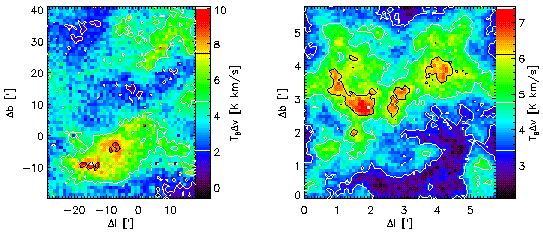 |
| V.Ossenkopf |
Comparing turbulent structures in models and observations |

|
The DFG project is part of the Priority program 1573 "Physics of the Interstellar Medium".
Principal investigors: Volker Ossenkopf & Robert Simon
Collaborators: Nicola Schneider, Timea Csengeri, Alex Lazarian, Blakeley Burkhart, Ralf Klessen, Jürgen Stutzki
Summary
Large surveys in the different tracers for the ISM (dust continuum, HI 21cm, low-J CO, [CI] and [CII]) have become available or are going to be observed in the near future with new observatories and instrumentation. In parallel, numerical (M)HD-simulations have matured to a state where they cover a relevant range of spatial scales in full 3D-treatment and address different physical scenarios for the driving, development, and dissipation of turbulence. To compare observations and simulations, a large suite of sophisticated statistical measures of the turbulent structure of interstellar clouds have been developed and are being applied.
In this project we systematically compare statistical properties of large scale mapping observations of ISM clouds in the different tracers with simulated observations based on turbulence models. The different statistical tools are going to be combined to resolve various aspects in the characterisation of interstellar turbulence: on the one hand the observational bias introduced by the limitations of any measured data set obtained with today’s observational technology, on the other hand physical mechanisms such as the phase transition from atomic to molecular gas at cloud boundaries, strong deviations from local thermodynamic equilibrium, dynamical instabilities driven by induced pressure gradients, and the so-far unknown impact of the radiation pressure from the interstellar radiation field.
Background
Observations of molecular clouds show a large variety of complex structures often described as filamentary, irregular or fractal. Interstellar turbulence forms hierarchical and self-similar structures over a wide range of scales. Due to the complex structure it is impossible to deduce the full geometric and dynamic structure of interstellar clouds from astronomical observations. Turbulence models are needed. As they will never exactly match the observed configuration, statistical methods are needed to quantify the observational results and to compare them with turbulent cloud models. Only in an iterative comparison of turbulence models and observations we can answer the questions on the origin of the complex structures, their evolution, their role in star formation and the general dynamical balance in the Milky Way.
Measuring the turbulent and fractal structure
We develop and test measures to quantitatively describe the structure of turbulent interstellar clouds. Main progress in the past was achived on three tools:
- Delta-variance analysis introduced by Stutzki et al. (1998) and extended by Ossenkopf et al. (2008);
- Centroids velocity studies of molecular lines;
- Scaling of velocity channel maps
More valuable additional information is hidden in the map anisotropy as measured by an adapted version of the Delta-variance analysis and the velocity structure as measured by a generalized Larson relation. A combination of the investigation of the general map appearance, the Delta-variance, the determination of the smoothness and wing behaviour of line profiles and the investigation of single channel maps is necessary to obtain a reliable cloud modeling.
Radiative transfer in fractal media
Closely related to the study of molecular cloud structure is the inverstigation and theoretical modelling of line radiative transfer in turbulent clouds needed to translate between the three-dimensional physical cloud structure and the observable line profiles.

Comparison of the CO 2-1 map of MCLD123.5+24.9 in the Polaris Flare taken with the KOSMA 3m telescope (left) and the corresponding map from a simple fractal cloud model (right). The fractal model is able to reproduce the statistical properties of the observation and shows thus a similar kind of structure.
The line radiative transfer in three dimensional turbulent structures is simulated and the resulting maps are compared to the observations. This extends the analysis to the third dimension providing a clue to the real cloud structure. From comparisons with MHD models we can learn about the nature of turbulence in molecular clouds.
Main objectives
The goal of the project is to quantify the agreements and disagreements of observed and simulated interstellar cloud structures. This involves three aspects:
- Identify observable tracers which are sensitive to different aspects of cloud structures, in particular the statistics of their chemical, dynamical, and energetical state.
- Identify statistical tools that are most sensitive to quantify the differences in the structure of observed and simulated structures with respect to the different aspects of interstellar turbulence.
- Quantify the fundamental limitations to observational data obtained by today’s telescopes that affect the comparison between simulations and observed data.
The project will bridge the gap between sophisticated hydrodynamic and magnetohydrodynamic simulations of turbulence in the interstellar medium on the one hand and the large set of observational data obtained from extended mapping projects in lines and continuum over the last years. The tools to compare both sides have to be conclusive in characterizing which aspects of the simulations match the observed properties and as to where differences originate from. This covers the formation of different chemical tracers at certain conditions, in particular the formation of molecules at cloud surfaces and PDRs, the energy balance in the simulations traced by the thermal dust emission and the excitation of different species, and the information on the turbulent and systematic velocity fields included in the spatial variation of the profiles of atomic and molecular lines.
Special emphasis will be given to aspects of phase transitions and non-LTE effects as they can be simulated since only recently in the turbulence models and the KOSMA group has a long observational experience record for them collected in the frame of the study of PDR physics and chemistry. Within this project, we will address the topic by using various cross-correlation measures that compare the statistical properties of data sets taken for different species and tracing different temperature regimes.
Last change: 03/18/2012